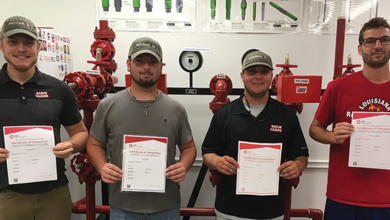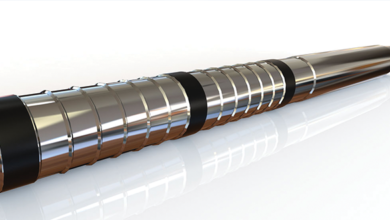Entrepreneurs pitch new technologies at IADC’s ART Spark Tank
By Eva Vigh, Editorial Coordinator
The IADC Advanced Rig Technology (ART) Committee held its fifth Spark Tank in Houston on 6 December. The forum, launched in June 2016, provides entrepreneurs with an opportunity to pitch their new technologies and products to a panel of operators and drilling contractors – also called sharks – who then provide their feedback.
At the December meeting, four entrepreneurs showcased their technologies to three panelists: Kelli Fereday, Director of Subsea Wells, BP; Alan Quintero, Chief Technology Officer, Board Member, NACD Governance Fellow, Rowan Companies; and Keith Lynch, Wells Operations Advisor-Unconventional Assets, ConocoPhillips. The event was moderated by Robin Macmillan, Senior Vice President for Business Development at National Oilwell Varco (NOV) and Chairman of the IADC ART Committee.
SaferUnion
R&H Machines’ SaferUnion, which provides an alternative to conventional hammer unions, was the first technology presented. The tool consists of a nut, torque wrench and 48-in. bar that offers an average of 18% more torque compared with conventional hammer units, according to Rae Burrows, Product Champion of SaferUnion. The bar inserts into the torque wrench, which is then inserted into one of the nut’s eight access points, located every 45°. The bar comes equipped with a detachable connector piece on one end, allowing for the application of additional torque without any damage to the bar. The driver behind the development of the tool was to eliminate safety hazards associated with hammer unions.
Self-drilling apps
AI Driller, an automation company that provides self-drilling applications, is planning to roll out a series of drilling modules, beginning with an ROP Module and Auto-Slider. The ROP Module, which is certified on NOV’s NOVOS system, calculates WOB channel based on historic drilling data. AI Driller is testing the module’s logic and plans to expand it as an advisory system. The company will then install and run the application on a NOVOS rig with human supervision, and eventually without supervision, according to CEO Marat Zaripov.
The Auto-Slider, which is under testing, takes inputs, such as distance, inclination and release torque, and applies autonomous directional drilling control for sliding with a conventional drilling motor. Based on results from a single well drilled in the Permian Basin, the automated slider can provide up to a 90-min improvement in slide orientation in the curve and 160 min in the lateral, Mr Zaripov said.
KnowFlow System
The third technology presented was the KnowFlow System, an early kick detection system that will measure real-time bi-directional changes in flow in a marine riser under all operational conditions. “We wanted to develop a system that would isolate the actual real-time change in flow rate in the riser to eliminate the heave, pitch and roll of the MODU,” said Kirk Cottrell, President and CEO of KnowFlow Systems.
The system is comprised of a flanged bolt-on flow module with a flow-monitoring device, mounted on the marine riser. Flow information is displayed in real time on the system’s primary display, or the driller’s screen, and is transmitted to off-site locations to authorized personnel.
Cerebra
Flutura Business Solutions presented an artificial intelligence-based industrial IoT platform, which has diagnostic and prognostic capabilities that can reduce operating costs and unscheduled downtime. Cerebra, which has been deployed on 165 rigs worldwide, has three modules powered by artificial intelligence and sensor data streams that catch problems earlier than traditional methods. The first is Cerebra State assessment, which helps maintenance engineers troubleshoot a remote asset and reduce trips to the rig. Cerebra Diagnostics “helps reliability engineers dig deeper into causal factors and improve first-time resolution of trouble tickets,” said Kurt Pedersen, VP of Operations. The third, Cerebra Prognostics, helps predict an imminent fault mode and trigger proactive action, thereby reducing NPT. DC
Click here to register for the next IADC Spark Tank on 4 April.






